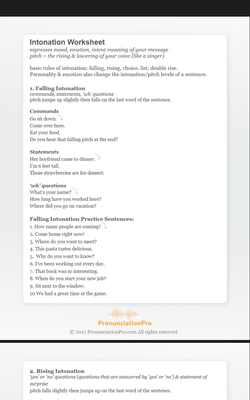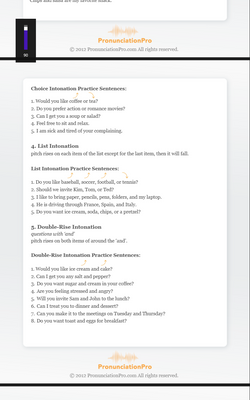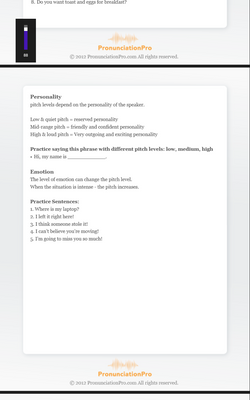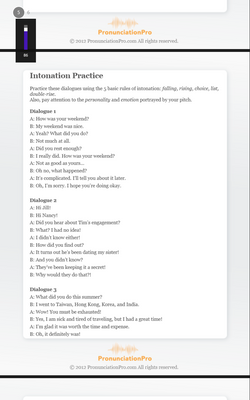May 3, 2024
Intonation Exercises & Practice


INTONATION SUMMARY
i. Practice identifying pitch words
ii. Take one sentence and try stressing a different word each time you read it
iii. Identify the emotion behind a statement
iv. Identify rising and falling intonation
INTONATION by Nicole Yurchak (from Verbling)
Learning English isn’t just about memorizing definitions and stringing words together correctly in a sentence. If you want to be understood and clearly convey what you’re feeling, it’s vital that you pay attention to your tone and word stresses. How do you do this? Try the four exercises below.
1. Practice identifying pitch words
Pitch words are the words in a sentence that are most relevant and allow the listener to interpret the meaning behind the statement. There are five different general categories of pitch words that you should try listening for whenever you hear a native speaker talk:
• High pitch words = new information
• Extra-high pitch words = emphasis to help listener understand something
• Rising pitch words = correcting previously incorrect information
• Scoop pitch words = expressing uncertainty
• Low pitch words = emphasizing information that is not new
2. Take one sentence and try stressing a different word each time you read it
Start with a sentence such as “I will go to the store if I have time,” and try saying it while stressing different words (“I will go to the store if I have time,” “I will go to the store if I have time,” and so on). Notice how changing the stressed words can actually change the meaning of the sentence.
3. Identify the emotion behind a statement
In English, intonation helps convey the intention of your words. For example, if you said something like, “I should do my homework,” placing the stress on “should” actually suggests that you’re about to come up with an excuse to avoid your homework (“I should do my homework, but I don’t have time”). Take one sentence and experiment with different syllable stresses and intonation to convey different feelings, such as excitement or seriousness.
4. Identify rising and falling intonation
Listen to a series of questions in English. If you don’t have a recording, ask a native English-speaking friend or native speaker on Verbling to ask the questions. Try to identify whether each question is rising (going up in pitch at the end) or falling (going down in pitch at the end). You should start to notice certain patterns. For example, questions that can be answered by “yes” or “no” typically have a rising intonation, while questions that start with “who,” “what,” “when,” “where,” or “why” typically have a falling intonation.
VOCABULARY
Memorising (UK) / Memorizing (US)
Convey (Con-vay)
Native (Nay-tiv)
Identify
Seriousness
Emphasizing
Emphasis
Pitch
Uncertainty (Un-CERT-tinty)
Experiment
INTONATION PRACTICE






THE END!
By undefined
13 notes ・ 4 views
English
Intermediate